Introduction
The success of retention with removable retainers is highly dependent on efficient patient compliance. The aim of this study was to quantify patient compliance with removable retainers using microelectronic wear-time documentation during the retention phase.
Methods
One hundred patients, between 13 and 20 years of age, were retained with removable Hawley retainers and functional appliance retainers after successful multibracket treatment at the University Hospital of Tübingen, Germany, and in 4 private practices in Germany. Microsensors were incorporated into the orthodontic retainers by polymerization, and daily wear time was documented in 15-minute intervals during the retention phase for up to 15 months. Patient compliance was quantified with wear-time documentation. Additionally, the influences of age, sex, place of treatment, device type, and health insurance status on compliance were determined and statistically evaluated.
Results
Most study participants complied with the prescribed wear time of 8 hours or more per day. Combined patient data indicated a median wear time of 7.0 hours per day over the evaluation period. Wear-time documentation showed either regular or irregular patterns of compliance. Initial compliance did not usually alter over the retention phase. Compliance was not influenced by device type, but age, sex, place of treatment, and insurance status produced changes in the median wear time of up to 50%.
Conclusions
Electronic wear-time documentation of patients’ compliance is an easily comprehensible measurement that allows orthodontists to examine the patient’s contribution to the success of retention and personalize treatment accordingly. Place of treatment and health insurance status are more closely associated with compliance than are basic patient demographics.
The aim of orthodontic retention is to stabilize the position of the teeth after orthodontic treatment in optimal esthetic and functional positions. In the retention phase, the final alignment of the dentition is maintained because the associated soft tissues remodel at a rate above the baseline, and the remodeling process varies among different tissue types. Various methods of retention are applied ; the main types are the removable Hawley, vacuum-formed, and fixed retainers in the United States. In 2010, Hawley retainers were the most commonly used, as reported by active members of the American Association of Orthodontists. However, their success is related to patients’ compliance. Lack of compliance can destroy the best treatment planning and the most promising treatment strategy.
The use of removable retainers means the responsibility for retention lies with the patient. Compliance with removable retainer usage is out of the control of the orthodontist. This can lead to frustration for both practitioners and patients. Opinions vary about how many hours the removable retainers should be worn per day. It has been reported that more than 50% of patients admitted that they did not wear their retainers as instructed; the most common reasons were discomfort and forgetfulness. There are wide variations in the retention regimen used by orthodontists, varying from immediate night-only wear of retainers to 3 to 6 months of full-time wear followed by night-only wear. Hawley retainers worn only at night were shown to be equally effective at reducing relapse as were the same retainers worn full time for 6 months and only nightly thereafter.
The results of previously published studies about wear time and compliance were based only on self-reporting of compliance with questionnaires and not objective experimentally determined wear times. In practice, most orthodontists develop their own retention protocol based on either what they were taught in residency or their clinical experience. With no method of objectively determining whether patients follow the prescribed wear time, orthodontists cannot assess whether unsatisfactory changes in tooth position are caused by poor compliance or by an ineffective retainer.
New technologies for the objective measurement of wear time using microsensors incorporated into removable retainers now make experimental quantification of patient compliance possible. Wear-time measurement and documentation can be performed simply and routinely by staff in an orthodontic office. The overarching purposes of this study were to quantify removable retainer compliance during the first retention phase and to evaluate the potential association of compliance with several demographic, clinical, and social variables such as age, sex, retainer type, place of treatment, and type of health insurance. A further aim was to determine how much patient compliance can realistically be expected during treatment with removable retainers.
Material and methods
One hundred patients (52 male, 48 female) recruited between January 2011 and June 2012 participated in the study, based on the following inclusion criteria: age between 13 and 20 years, no syndromic illnesses, completed active orthodontic treatment with an indication for use of a removable retainer with a microsensor completely incorporated by polymerization, wear time of 3 or more months after the introduction of the device, and checkup appointments at least every 100 days. The mean patient age at the start of treatment was 15.46 years (range, 13-20 years). Wear-time documentation and follow-up were variable, depending on when the patients were recruited to the study; however, all patients had at least 90 days of wear-time documentation. Representative compliance measured by the wearing times of 15 randomly selected patients with different periods of long-duration therapy are documented in Table I . Twenty-six patients were treated at the Department of Orthodontics at the University Hospital of Tübingen, and 74 patients were treated in independent specialist practices in Germany. There were no significant differences in age and sex of the patient groups from the different locations. However, the health insurance status was different among the patients. Statutory health insurance in Germany through sickness funds is compulsory for workers whose gross income does not exceed a certain threshold, for unemployed persons, and for certain other population groups. Employees with incomes above the threshold can opt into a voluntary sickness fund (private health insurance), which is more expensive but offers additional benefits. About 88% of the subjects were covered by the statutory health insurance (74% obligatory, 14% voluntarily). No patient was excluded from the study during the treatment period. Written patient consent and that of the parent or legal guardian when necessary was obtained for the incorporation of the wear-time sensor and subsequent data evaluation. The study was approved by the ethics commission of the University of Tübingen (project number 339/2012B01). The influences of the following parameters on wear times were evaluated: age, sex, type of retention device (Hawley retainer or functional appliance retainer), place of treatment (university hospital or private orthodontic practice), and health insurance status (statutory health insurance or private health insurance).
| Patient | Treatment months | |||||
|---|---|---|---|---|---|---|
| 1-3 | 4-6 | 7-9 | 10-12 | |||
| Subject | Sex | Age (y) | Median wear time (h) | |||
| 47 | F | 18.1 | 9.0 | 9.2 | 9.0 | 9.2 |
| 33 | F | 15.3 | 5.9 | 6.9 | 8.1 | |
| 17 | F | 18.1 | 7.7 | 8.3 | 9.0 | 9.2 |
| 75 | M | 15.7 | 2.6 | 4.4 | ||
| 80 | M | 16.1 | 3.2 | 4.0 | ||
| 65 | M | 15.7 | 2.1 | 2.6 | ||
| 25 | M | 16.7 | 11.2 | 10.8 | ||
| 43 | M | 17.5 | 12.1 | 11.8 | ||
| 36 | F | 14.9 | 4.0 | 7.0 | 5.8 | 5.1 |
| 11 | M | 14.5 | 6.7 | 8.6 | 7.2 | 8.1 |
| 18 | F | 18.2 | 8.5 | 8.2 | 6.5 | 6.7 |
| 41 | F | 15.2 | 9.0 | 9.1 | 9.8 | |
| 7 | F | 13.2 | 9.0 | 9.4 | 10.0 | 9.1 |
| 13 | M | 13.5 | 8.7 | 9.7 | 9.2 | 9.1 |
| 31 | M | 13.6 | 8.7 | 10.0 | 10.1 | 8.4 |
Hawley retainers in both jaws were used in 71 patients, and functional appliance retainers in 29 patients ( Fig 1 ). The devices were made with Orthocryl (Dentaurum, Ispringen, Germany) according to standard procedures. It was advised that the device should be worn by the patient for a minimum of 8 hours a day. The patients were informed that longer daily wear times were favorable because they could positively influence the outcome of the retention phase.
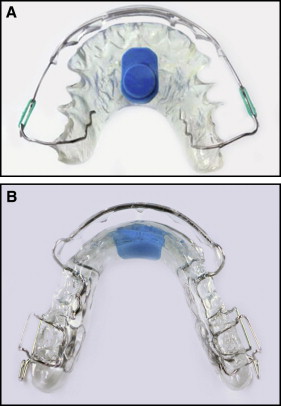
The TheraMon-Sensor (Handelsagentur Gschladt, Hargelsberg, Austria, or Forestadent, Pforzheim, Germany) was used in this study because it offers significant advantages compared with the Smart Retainer, as described by Schott and Göz. The microsensor was completely embedded in the polymer matrix of the maxillary removable Hawley retainer and the functional appliance retainers without difficulty ( Fig 1 ). The nondetachable sensors did not affect the comfort of the retainer. During the entire treatment, the ambient temperature was measured by the sensor every 15 minutes and saved in its integral memory, together with the time and the date. At regular checkup appointments, the recorded data were transmitted outside the oral cavity to a computer within seconds via the TheraMon reading station using radio-frequency identification technology and processed with the proprietary TheraMon software (version 2.1.0.13). The actual measured temperature of the oral cavity was transformed by the software to wear times, distinguishing wear times from nonwearing times. The software identified possible temperature manipulations by the patients as abnormal, with conspicuous measurement values highlighted with the built-in detailed analysis. Data processed by the dental staff were displayed as wear-time graphics ( Figs 2-4 ).
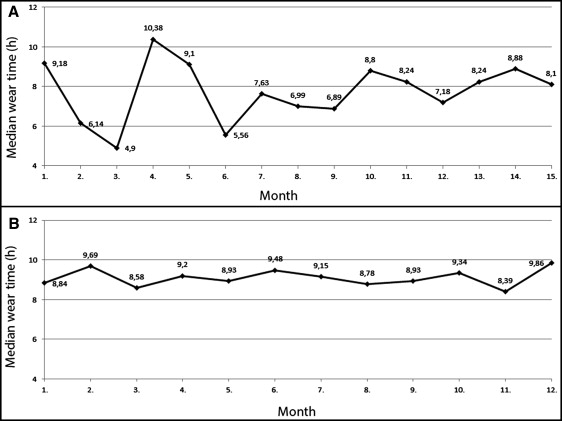
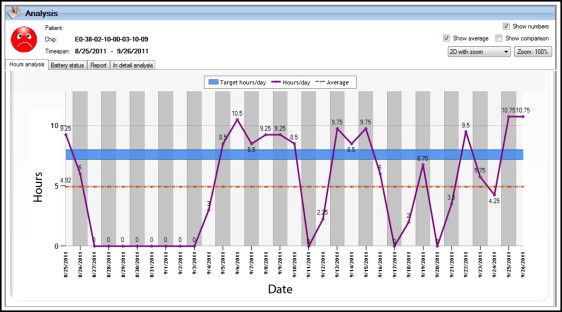
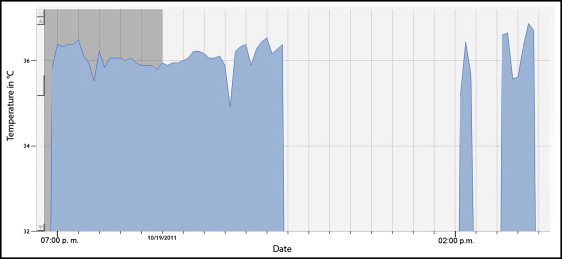
Statistical analysis
Statistical analysis of the data was performed with SPSS for Windows (version 20; IBM SPSS, Chicago, Ill). The data distribution was tested for normality using the Shapiro-Wilks t test. Because the mean wear times were mostly not normally distributed, minimum, 25th percentile, median, 75th percentile, and maximum values were used as statistical indexes, and nonparametric tests were used for data analysis. The mean monthly wear times of each group are shown in boxplots ( Fig 5 ), and the summarized mean wear times over a 3-month period are presented in Table II . The Mann-Whitney U test was used to investigate the differences in wear times between the groups. The alpha level was set at 0.05. Thus, P ≤0.05 was considered significant.
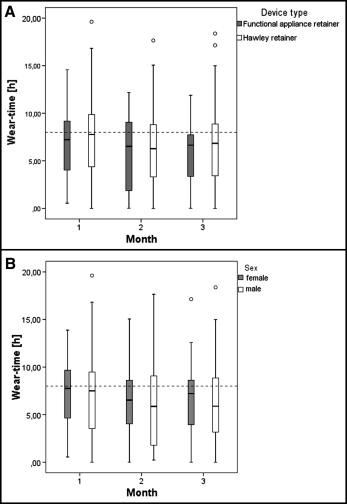
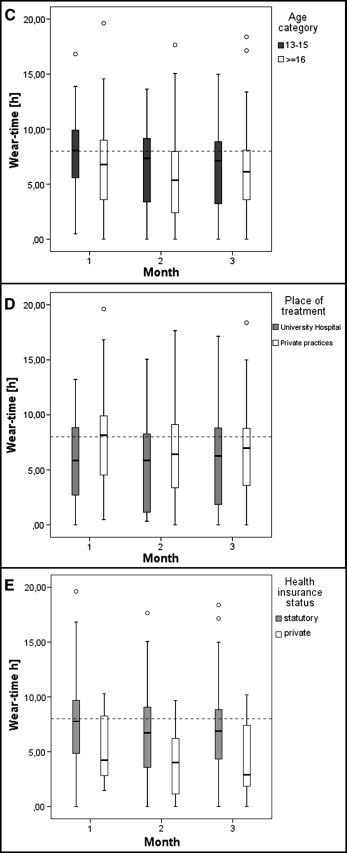

Stay updated, free dental videos. Join our Telegram channel

VIDEdental - Online dental courses


